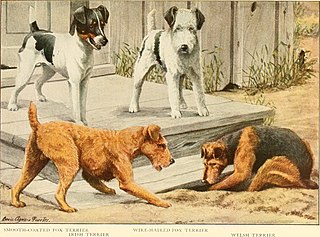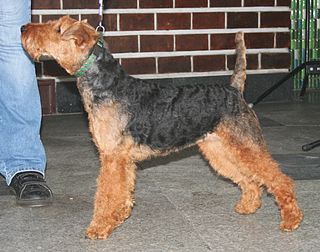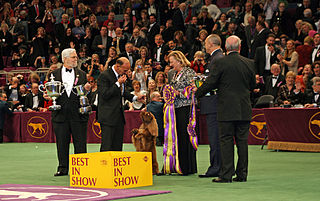
The Airedale Terrier, also called Bingley Terrier and Waterside Terrier, is a dog breed of the terrier type that originated in the valley (dale) of the River Aire, in the West Riding of Yorkshire, England. It is traditionally called the "King of Terriers" because it is the largest of the terrier breeds. The Airedale was bred from the Old English Black and Tan Terrier, the Otterhound and probably some other Terrier breeds, and has contributed to other dog breeds, such as the Yorkshire Terrier. Originally bred to serve as a versatile hunting and all around working farm dog, in Britain this breed has also been used as a war dog, guide dog and police dog. In the United States, this breed has been used to hunt big game, upland birds, and water fowl, and serve in many other working capacities.

Terrier is a type of dog originally bred to hunt vermin. A terrier is a dog of any one of many breeds or landraces of the terrier type, which are typically small, wiry, game, and fearless. Terrier breeds vary greatly in size from just 1 kg (2 lb) to over 60 kg and are usually categorized by size or function. There are five different groups of terrier, with each group having different shapes and sizes.

The American Cocker Spaniel is a breed of sporting dog. It is a spaniel type dog that is closely related to the English Cocker Spaniel; the two breeds diverged during the 20th century due to differing breed standards in the US and the UK. In the United States, the breed is usually called a Cocker Spaniel, while elsewhere in the world, it is called an American Cocker Spaniel to distinguish it from its older English cousin. The word cocker is commonly held to stem from their use to hunt woodcock in England, while spaniel is thought to be derived from the breed's origins in Spain.

The Patterdale Terrier is a breed of dog descended from the Northern terrier breeds of the early 18th century.

Cocker Spaniels are dogs belonging to two breeds of the spaniel dog type: the American Cocker Spaniel and the English Cocker Spaniel of which are commonly called simply Cocker Spaniel in their countries of origin. In the early 20th century, Cocker Spaniels also included small hunting spaniels.

Fox Terriers are two different breeds of the terrier dog type: the Smooth Fox Terrier and the Wire Fox Terrier. Both of these breeds originated in the 19th century from a handful of dogs who are descended from earlier varieties of British terriers, and are related to other modern white terrier breeds. In addition, a number of breeds have diverged from these two main types of fox terrier and have been recognised separately, including the Jack Russell Terrier, Miniature Fox Terrier and Rat Terrier. The Wire and Smooth Fox Terriers share similar characteristics, the main differences being in the coat and markings. They have been successful in conformation shows, more prominently in America than their homeland.

The Bedlington Terrier is a breed of small dog named after the mining town of Bedlington, Northumberland in North East England. Originally bred to hunt, the Bedlington Terrier has since been used in dog racing, numerous dog sports, as well as in conformation shows and as a companion dog. It is closely related to the Dandie Dinmont Terrier, Whippet and Otterhound.

The Welsh Terrier originates from Wales and was originally bred for hunting fox, rodents and badger; but during the last century, it has mainly been bred for showing. Despite this, it has retained its terrier strength of character. The Welsh Terrier has been claimed to be the oldest existing dog breed in the UK.

The Toy Fox Terrier is a small terrier breed of dog, directly descended from the larger Smooth Fox Terrier but since 1936 registered in USA as a separate breed at UKC
Toy dog traditionally refers to a very small dog or a grouping of small and very small breeds of dog. A toy dog may be of any of various dog types. Types of dogs referred to as toy dogs may include spaniels, pinschers and terriers that have been bred down in size. Not all toy dogs are lap dogs.

The Westminster Kennel Club Dog Show is an all-breed conformation show, since 2021 has been conducted at Lyndhurst in Tarrytown, New York.

The Smooth Fox Terrier is a breed of dog, one of many terrier breeds. It was the first breed in the fox terrier family to be given official recognition by The Kennel Club. It is well known, and although not a widely popular breed today outside hunting and show circles, it is extremely significant due to the large number of terriers believed descended from the breed.

The Wire Fox Terrier is a breed of dog, one of many terrier breeds. It is a fox terrier, and although it bears a resemblance to the Smooth Fox Terrier, they are believed to have been developed separately.

The Jagdterrier is a type of working terrier, originating in Germany, that is used for hunting quarry both above and underground. This breed of terrier is also called the German Hunt Terrier.

The Black and Tan Terrier was a broad breed or type of terrier that was one of the earliest terriers breeds. Although it is now extinct, it is believed to be the ancestor of all modern Fell Terrier breeds and the Welsh Terrier, a breed recognised by The Kennel Club.

A working terrier is a small type of dog which pursues its quarry into the earth. According to the Oxford English Dictionary, the name dates back to at least 1440, derived from French chien terrier 'digging dog', from Medieval Latin terrarius, ultimately from Latin terra (earth).

Ch. Efbe's Hidalgo At Goodspice, also known as Charmin, was a male Sealyham Terrier who was the Best in Show at the American Kennel Club National Championship in 2007, World Dog Show in 2008, and Crufts in 2009. He also won the Terrier Group at the Westminster Kennel Club dog show in 2008.

Ch. Kenmare Sorceress (1909–1920), an Airedale Terrier, was the first of its breed to have won the Westminster Kennel Club Dog Show, in 1912. She was originally from Wales, but was imported into the United States by William P. Wolcott in September 1910.
Ch. Torums Scarf Michael in Liverpool, England, was a Kerry Blue Terrier who is best known for being the 2000 Best in Show winner at Crufts, and 2003 Best in Show of the Westminster Kennel Club Dog Show. He is the first dog to win the "Triple Crown" of dog shows, having also won the 2002 AKC/Eukanuba National Invitational Championship.



















